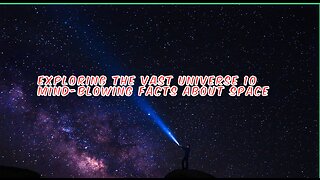10 Facts about Space#fascinatingfacts
10 fascinating facts about space:Of course, here are 10 fascinating facts about space:
Vastness Beyond Imagination: Space is incredibly vast. The observable universe is estimated to be about 93 billion light-years in diameter, containing billions of galaxies, each with billions of stars.
Cosmic Microwave Background: The cosmic microwave background radiation is a faint glow of radiation left over from the Big Bang. It's one of the most important pieces of evidence for the Big Bang theory.
Black Holes: Black holes are incredibly dense regions in space where gravity is so strong that nothing, not even light, can escape their gravitational pull. They form when massive stars collapse under their own gravity.
Space Oddities: There are strange phenomena like quasars, which are incredibly bright and distant objects powered by supermassive black holes. They emit more energy than billions of stars combined.
Weightlessness: Astronauts on the International Space Station (ISS) experience microgravity, often called weightlessness. This is because they are in a continuous state of freefall around the Earth.
The Great Red Spot: Jupiter's Great Red Spot is a giant storm that has been raging for at least 400 years. It's so massive that it could fit Earth inside it multiple times.
Exoplanets: Exoplanets are planets that orbit stars outside our solar system. Thousands have been discovered, and some are even in the habitable zone where conditions might be suitable for life.
Pulsars: Pulsars are highly magnetized, rotating neutron stars that emit beams of electromagnetic radiation. They rotate incredibly fast, and their precise pulses make them useful tools for studying the universe.
The Oort Cloud: The Oort Cloud is a hypothetical region far beyond the orbit of Pluto that is believed to contain a vast number of icy bodies and comets. It's thought to be the source of long-period comets.
Dark Matter and Dark Energy: The majority of the universe's mass-energy content is made up of dark matter and dark energy, both of which are mysterious and not yet fully understood. Dark matter provides the gravitational "glue" that holds galaxies together, while dark energy is responsible for the accelerated expansion of the universe.
Vastness Beyond Imagination: Space is incredibly vast. The observable universe is estimated to be about 93 billion light-years in diameter, containing billions of galaxies, each with billions of stars.
Cosmic Microwave Background: The cosmic microwave background radiation is a faint glow of radiation left over from the Big Bang. It's one of the most important pieces of evidence for the Big Bang theory.
Black Holes: Black holes are incredibly dense regions in space where gravity is so strong that nothing, not even light, can escape their gravitational pull. They form when massive stars collapse under their own gravity.
Space Oddities: There are strange phenomena like quasars, which are incredibly bright and distant objects powered by supermassive black holes. They emit more energy than billions of stars combined.
Weightlessness: Astronauts on the International Space Station (ISS) experience microgravity, often called weightlessness. This is because they are in a continuous state of freefall around the Earth.
The Great Red Spot: Jupiter's Great Red Spot is a giant storm that has been raging for at least 400 years. It's so massive that it could fit Earth inside it multiple times.
Exoplanets: Exoplanets are planets that orbit stars outside our solar system. Thousands have been discovered, and some are even in the habitable zone where conditions might be suitable for life.
Pulsars: Pulsars are highly magnetized, rotating neutron stars that emit beams of electromagnetic radiation. They rotate incredibly fast, and their precise pulses make them useful tools for studying the universe.
The Oort Cloud: The Oort Cloud is a hypothetical region far beyond the orbit of Pluto that is believed to contain a vast number of icy bodies and comets. It's thought to be the source of long-period comets.
Dark Matter and Dark Energy: The majority of the universe's mass-energy content is made up of dark matter and dark energy, both of which are mysterious and not yet fully understood. Dark matter provides the gravitational "glue" that holds galaxies together, while dark energy is responsible for the accelerated expansion of the universe.
-
 2:25
2:25
Zachrates
1 year ago10 Amazing and Fascinating Facts about Space
1 -
 2:06
2:06
MindBendingFacts
1 year ago5 Fascinating and Unusual Facts About Space
5 -
 0:10
0:10
Facts 4 You
1 year agoSpace facts | Interesting Facts |
17 -
 3:34
3:34
Be Amazed with Top 10
11 months agoTop 10 Mind-Blowing Facts About Space
8 -
 2:20
2:20
Future Astronauts
4 months ago20 strange but true space facts of 2024!
10 -
 15:47
15:47
It Came From Social Media!
5 months ago12 Unbelievable Cosmic Trivia Facts You Won't Believe!
267 -
 5:29
5:29
ThisIsWeird
1 year agoExploring the Vast Universe 10 Mind-Blowing Facts About Space
183 -
 3:43
3:43
OatmealLovers
1 year agoTOP 10 FASCINATING FACTS ABOUT SPACE
4 -
 0:50
0:50
caropage
2 years agoInteresting Space Facts That’ll Blow Your Mind Part 1 #shorts
34 -
 3:18
3:18
gcontent
6 years agoFive Interesting Facts about Earth
5.87K1